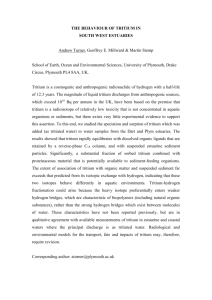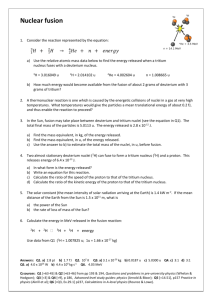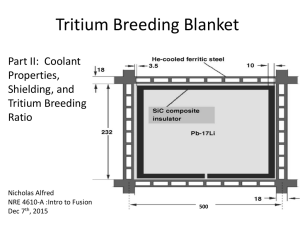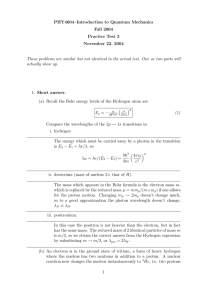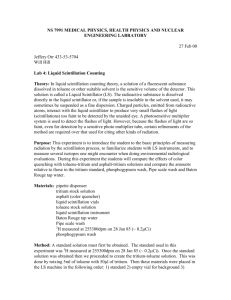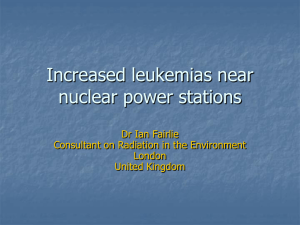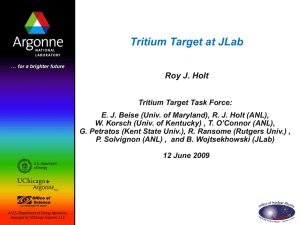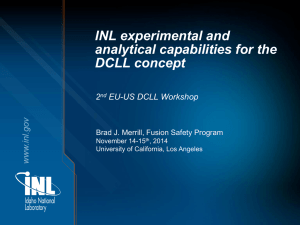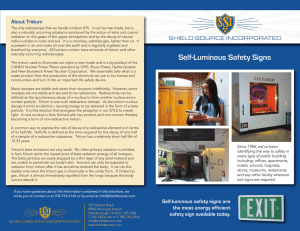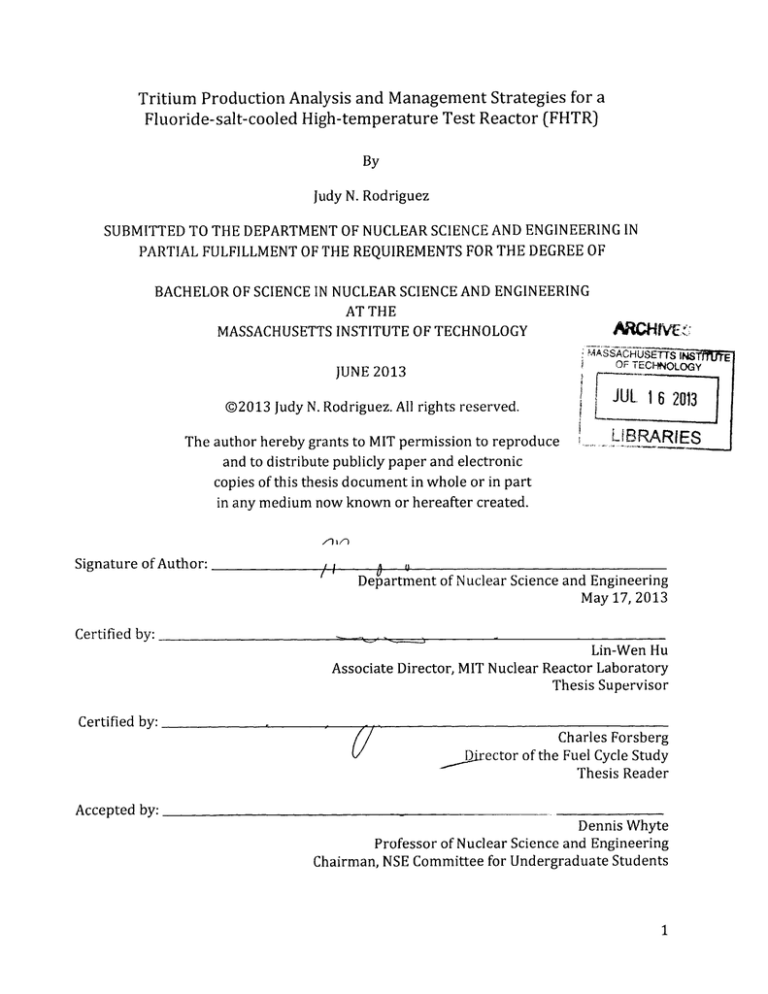
Tritium Production Analysis and Management Strategies for a
Fluoride- salt- cooled High-temperature Test Reactor (FHTR)
By
Judy N. Rodriguez
SUBMITTED TO THE DEPARTMENT OF NUCLEAR SCIENCE AND ENGINEERING IN
PARTIAL FULFILLMENT OF THE REQUIREMENTS FOR THE DEGREE OF
BACHELOR OF SCIENCE IN NUCLEAR SCIENCE AND ENGINEERING
AT THE
INSTITUTE
OF TECHNOLOGY
MASSACHUSETTS
ARtCHIVES
SSAdHUSETTS INST
OF TECFINOLOGy
JUNE 2013
@2013 Judy N. Rodriguez. All rights reserved.
The author hereby grants to MIT permission to reproduce
and to distribute publicly paper and electronic
copies of this thesis document in whole or in part
in any medium now known or hereafter created.
JUL 16 2013
LIBRARIES
Signature of Author:
Department of Nuclear Science and Engineering
May 17, 2013
Certified by:
Lin-Wen Hu
Associate Director, MIT Nuclear Reactor Laboratory
Thesis Supervisor
Certified by:
(7
Charles Forsberg
ector of the Fuel Cycle Study
Thesis Reader
Accepted by:
Dennis Whyte
Professor of Nuclear Science and Engineering
Chairman, NSE Committee for Undergraduate Students
1
E
Tritium Production Analysis and Management Strategies for a
Fluoride-salt-cooled High-temperature Test Reactor (FHTR)
By
Judy N. Rodriguez
Submitted to the Department of Nuclear Science and Engineering
on May 17, 2013 in Partial Fulfillment of the
Requirements for the Degree of Bachelor of Science in
Nuclear Science and Engineering
ABSTRACT
The Fluoride-salt-cooled High-temperature Test Reactor (FHTR) is a test reactor
concept that aims to demonstrate the neutronics, thermal-hydraulics, materials, tritium
management, and to address other reactor operational and maintenance issues before a
commercial Fluoride-salt-cooled High-temperature Reactor (FHR) can be deployed. The
MIT Nuclear Systems Design class proposed a design for a 100 MW FHTR that uses
enriched- 7Li flibe (Li2BeF4), has both thermal and fast flux testing positions for fuel and
materials testing, and provides a neutron flux greater than 3E14 n/cm2 -s for accelerated
irradiation testing. One of the key technical issues of the FHR and FHTR is tritium
generation from the flibe coolant and its radiological control. The objectives of this study
are: 1) to provide an overview of tritium production in various types of nuclear systems, 2)
to estimate the tritium source term in the FHTR using the ORIGEN-S computer code, and 3)
to propose a tritium management strategy for the FHTR. A review of existing nuclear
systems shows that tritium is the primary radionuclide in liquid and gaseous tritium
release. Light water reactors release up to several hundred curies per year for which
various tritium removal and control strategies have been developed and implemented.
Using the ORIGEN-S code analysis, tritium production for the MIT FHTR design at 20 MW is
estimated to be about 2600 Ci per year (based on a 70% capacity factor and-10 Ci/day),
with 99.99% enriched- 7Li flibe. Using this source term, a tritium removal rate of >90% is
proposed as a design target for the tritium control system of the FHTR in order to maintain
tritium release within the limits of existing nuclear reactors. Proposed tritium management
strategies for the FHTR include increasing the 7Li enrichment, carbon-based or metallic
getters, and inert gas sparging with a high-temperature recombiner system.
Thesis Supervisor: Lin-Wen Hu
Title: Associate Director, MIT Nuclear Reactor Laboratory
2
Acknowledgements
I would like to extend a sincere thank you to Dr. Lin-Wen Hu, my thesis advisor, for
suggesting my thesis topic and allowing me to contribute to the department in a
meaningful way. I am very grateful for the continuous feedback and for the help in
overcoming writing barriers. Thanks are also due to Dr. Charles Forsberg for taking the
time to read this text and providing valuable feedback.
I would also like to thank Dr. Michael Ames for his continuing guidance and support
with the ORIGEN-S code that allowed me to complete the most important part of this thesis,
and for taking the time to read part of this text and providing me with feedback.
Special thanks to the staff at the MIT Reactor lab; in particular Frank Warmsley and
Bill McCarthy for allowing me to conduct informational interviews, and Paul Nawazelski for
helping me with figures.
I am also thankful to the Department of Nuclear Science and Engineering; special
thanks to Professor Bilge Yildiz, Professor Anne White, Dr. Gordon Kohse, and Dr. Richard
Lanza for their advice and support throughout my time at MIT.
Finally, I would like to thank my family and my friends for their love and
encouragement.
3
Table of Contents
1
In tro d u ctio n ........................................................................................................................................................
5
1.1 Overview of the Fluoride-salt-cooled High-temperature Reactor (FHR).........5
6
1.2 Overview of the FHTR ...........................................................................................................................
1.3 Overview of Tritium Production in the FHTR ..............................................................................
8
1.4 Overview of Tritium Production in Other Nuclear Reactor Systems............ 9
11
1.5 Thesis Objectives...................................................................................................................................
2
Tritium Control and Management in Existing Nuclear Reactor Designs............
2.1 Tritium at the MIT Reactor (MITR) ...............................................................................................
2.1.1 Overview of the MITR..................................................................................................................
2.1.2 MITR Tritium Production and Limits ...................................................................................
2.1.2.1 Technical Specifications ..................................................................................................
2.1.2.2 Offsite Dose Lim its.................................................................................................................
2.1.3 MITR Tritium Managem ent.......................................................................................................
2.1.3.1 Recom biner System ...............................................................................................................
2.1.3.2 Heavy W ater Replacement..............................................................................................
2.1.3.3 Radiological Control of Heavy Water System Maintenance Activities.....
2.1.3.4 Stack Release ............................................................................................................................
2.1.3.5 Sewage Release .......................................................................................................................
2.2 Tritium in Fusion System s ................................................................................................................
2 .2 .1 HYLIF E-II ..........................................................................................................................................
2.2.2 Integrated Pool Fusion Reactor Concept (IPFR) ........................................................
2.2.3 JUPITER-II Program ....................................................................................................................
2.3 Tritium in the Pressurized Water Reactor (PW R)..................................................................
2.3.1 PW R Tritium Production ..........................................................................................................
2.3.2 PW R Tritium Managem ent .......................................................................................................
2.4 Tritium in CANDU Reactors..............................................................................................................
2.4.1 Overview of Tritium in CANDU Reactors............................................................................
2.4.2 Detritiation Processes .................................................................................................................
12
12
12
13
13
14
15
15
17
17
18
18
19
19
20
21
22
22
23
24
24
25
3
ORIGEN-S Analysis of the Tritium Source Term in the FHTR ...................
3.1 Tritium Production Estim ate ...........................................................................................................
3.2 ORIGEN-S Analysis................................................................................................................................
3.2.1 ORIGEN-S Description ................................................................................................................
3.2.2 FHTR Problem ................................................................................................................................
3.2.3 Analysis of Tritium Production in the FHTR .....................................................................
28
28
29
29
30
32
4
Proposed FHTR Tritium Managem ent Strategies............................................................................
34
5
Conclusion and Recom m endations for Future W ork...............................................................
35
6
R e fe re n ce s ........................................................................................................................................................
37
7
A p p e n d ice s .......................................................................................................................................................
7.1 Appendix A ORIGEN-S Input ............................................................................................................
7.2 Appendix B ORIGEN-S Output .....................................................................................................
39
39
40
4
1
1.1
Introduction
Overview of the Fluoride-salt-cooled High-temperature Reactor (FHR)
Research in the nuclear and materials engineering fields worldwide is currently
investigating a new reactor concept called the Fluoride-salt-cooled High-temperature
Reactor (FHR). The design features a low-pressure, high-temperature liquid fluoride-salt
coolant, coated-particle fuel, increased efficiency for electricity generation, process heat
production, and fully passive decay heat rejection. These qualities contribute to the
generation of electricity at a low cost while maintaining passive safety features,
overcoming current limitations of Light Water Reactors (LWRs) [1]. The concept of the FHR
must undergo further design study, materials and fuel irradiation tests, and operational
and safety evaluation before a full-scale power reactor can be built. The development of a
Fluoride-salt-cooled High-temperature Test Reactor (FHTR) will allow for the testing of
critical concepts in the FHR including the testing of materials, coolants, and the neutronics.
An interest in Molten Salt Reactors (MSRs) originated first in the 1950s and 1960s
as highly experimental designs. The interest evolved around the potential ability of the
MSR to burn actinides, operate as a breeding reactor for Thorium, provide a simplified fuel
cycle, and make way for limited transport of radioactive materials. Advances in HighTemperature Gas-cooled Reactor (HTGR) fuel technology, materials, and MSR technology
led to the development of the FHR concept. The MSR and FHR designs are mainly different
in the fuel aspect: the fuel in MSRs was dissolved in the molten salt coolant whereas the
fuel for the FHR is the same type of solid fuel developed for HTGRs.
The primary coolant candidate for the FHR is flibe (66.7%LiF-33.3%BeF 2) because it
has excellent heat transfer and neutronics properties, with a high melting point of 460'C
5
and boiling point of 1430*C that allow reactor operation at very high temperatures [2]. As a
result, flibe is also the primary coolant candidate for the FHTR. Tritium is a radioactive
isotope of hydrogen with an atomic mass of three that may be produced from neutron
capture reactions with the components of flibe, primary 6 Li. Tritium has a half-life of 12.3
years and is a pure beta emitter. At high temperatures, tritium behaves like hydrogen and
may diffuse through materials and escape from the reactor.
1.2
Overview of the FHTR [3]
Before the FHR becomes commercially viable, a test reactor is necessary to study
important aspects relevant to neutronics, thermal hydraulics, materials, and most relevant
to this case, methods for managing tritium. A preliminary 100 MW FHTR has been designed
by the 2012 MIT Nuclear Systems Design Class to prove commercial feasibility of and
provide accelerated testing for the FHR. The MIT FHTR design has notable features that
include: a large central thermal test position with a neutron flux greater than 3E14 n/cm 2 -s
for accelerated fuel and materials testing, numerous in/ex-core testing positions in contact
with the primary coolant, a coated-particle-based fuel form, and high inlet (>600'C) and
outlet (-700'C) temperatures to avoid salt freezing and provide the expected hightemperature environment of the commercial design. Numerous safety features have been
suggested in the FHTR design for tritium control and decay heat removal. Figure 1 shows
the core geometry layout of the MIT FHTR design and Table 1 shows the core's relevant
dimensions [4]. Table 2 shows the flux levels in several parts of the FHTR.
6
Coolant
Graphite
TRISO Fuel
Hafnum
Outer Test Position
Inner Test Position
Figure 1 MIT FHTR core geometry layout [4]
7
Table 1 MIT FHTR core geometry parameters [4]
Value (cm)
100
Dimension
Short Radius of the Core
Core Height
Radial Reflector Thickness
Axial Reflector Thickness
120
Short Radius of Assembly
40
30
12
Assembly Pitch
Fuel and Coolant Channel Radius
Fuel and Coolant Channel Pitch
Inner Test Position Radius
Outer Test Position Radius
25
0.8
1.8
12
4
Table 2 MIT FHTR 100 MW flux values of the average core and core test positions in n/cm 2 -s
[4]
1.3
Flux Position
Total Flux
Average Core
Inner Channel Test Position
Inner Center 1000 cm 3 Box
Outer Channel Test Position
2.85E14
5.28E14
6.90E14
2.79E14
Thermal Flux
(<0.625 eV)
2.28E13
3.25E14
4.53E14
2.00E13
Fast Flux
(>0.625 eV)
2.62E14
2.03E14
2.37E14
2.59E14
Overview of Tritium Production in the FHTR
A method that can monitor the production, removal, and release of tritium to the
environment must be demonstrated before it can be implemented in the commercial FHR
design. The main goal is to limit the dose to plant workers and the general public as
specified by the Code of Federal Regulations. This will be achieved by containing tritium in
the reactor system, removing it in a controlled manner, possibly through a getter and/or a
cover gas/recombiner system, and preventing a significant amount from diffusing through
reactor materials by employing barriers in heat exchangers and other sensitive areas, or
other methods.
8
Tritium in the flibe coolant is formed by neutron reactions with its constituents: 19 F,
6
Li, 7 Li, and 9 Be. The most prominent is the neutron reaction with 6 Li:
6Li+n
4He+
3H
which has a cross-section of 940 b for thermal neutrons at 0.025eV [13]. The tritium ions
formed in these reactions can combine with
19 F to
form the corrosive TF, becoming a target
of interest for removal from the coolant. When H2 is introduced into the salt at high enough
pressure, an isotopic exchange with TF can be induced to produce HT gas [5]. This HT gas is
an attractive target for tritium removal systems, and can be involved in a proposed
recombiner system.
In order to accurately determine the tritium production rate in the FHTR, variables
such as neutron flux, coolant temperature, and core geometry must be known. An ORIGENS analysis is employed to estimate the tritium production rate for up to five years without
removal. After determining the tritium production rate, retention and removal strategies
can be proposed. Simulation of tritium transport is out of the scope of this study, but should
be studied further to accurately determine the best management method and the potential
for release in accident scenarios.
1.4
Overview of Tritium Production in Other Nuclear Reactor Systems
Tritium production and its control have also posed an issue for other nuclear
systems mainly for radiological controls. There has been significant research in the MSRE
project (1950-60s) in which flibe was used as the primary and secondary coolant, and
studies of tritium breeding in flibe as fuel for fusion applications [6]. Currently, CANada
Deuterium Uranium (CANDU) reactors, Light Water Reactors (LWRs), and some research
9
and test reactors employ tritium control methods. The tritium production in a PWR,
CANDU, the MSRE, two FHR designs, and a fusion design are listed in Table 31. It is
important to note that the tritium production is highly based on the 7 Li enrichment in the
molten salt; the higher the 7Li enrichment, the less 6 Li available for the neutron capture
reaction that contributes the most to tritium production 2 .
Table 3 Tritium production in a PWR, CANDU, the MSRE, and two FHR designs.
Reactor
Reactor Power
PWR [7]
CANDU [8]
MSRE [8]
FHR [9]
1000 MWe
1000 Mwe
1000 Mwe
2400 MWt
FHR Baseline from UCBerkeley Design [8]
Fusion Designs [8]
900 MWt
Tritium Production
(Ci/day)
1.9
2740
2420
5000 (initial)
500 (equilibrium)
32.8 (equilibrium)
1000 MWe
4.2E6 3
7 Li
enrichment
n/a
n/a
99.99%
99.995%
99.995%
92.5%
While many technologies have been developed to control tritium release into the
environment in different reactor designs and fusion applications, there is a need to study
the feasibility of these technologies for the FHTR design based on estimates of total tritium
production and its behavior with the FHTR coolant and structural materials. This project
will address this issue to determine the best tritium management strategies for the FHTR
by estimating the MIT FHTR's long-term tritium production without removal, and assessing
the feasibility of current tritium management in other reactors and nuclear applications.
and equilibrium values exist due to the initial high production and then eventual
burnout of 6 Li in the flibe salt.
2 Natural abundance of 7 Li is 92.4%
3 Order of magnitude is much greater since tritium is purposely bred for fuel.
1 Initial
10
1.5
Thesis Objectives
The objectives of this thesis are as follows:
1) To provide an overview of tritium radiological control and management strategies
of the MIT reactor and other existing nuclear systems
2) To estimate the total tritium production expected in a reference FHTR using the
ORIGEN-S computer code, and
3) To propose a tritium management strategy for the FHTR
11
2
Tritium Control and Management in Existing Nuclear Reactor Designs
2.1
2.1.1
Tritium at the MIT Reactor (MITR)
Overview of the MITR
The MIT Nuclear Reactor Laboratory (MIT-NRL) is a leading university laboratory
that conducts interdisciplinary research. MIT-NRL operates a 6 MW light-water-cooled and
moderated, heavy-water-reflected reactor, the MIT Research Reactor (MITR). It is the
second largest university research reactor in the United States. The MITR utilizes flat, platetype finned, aluminum-clad fuel elements. The fuel is 93%-enriched U-235. Its mission is to
provide faculty and students from MIT and other institutions with both a state-of-the-art
neutron source and infrastructure required to facilitate use of the reactor [10].
Because it uses heavy water as a reflector and it has a very high neutron flux rate,
6E13 n/cm 2 -s, the MITR has strict limits on the level of tritium in both the heavy water
reflector and secondary (light water) cooling systems, as outlined in the MITR Technical
Specifications [11]. Tritium is formed whenever a deuterium nucleus captures a neutron, as
illustrated in the following reaction:
1H + n
1H
Although the absorption cross-section for thermal neutrons of deuterium is small
(0.508 mb) [12] and relatively little tritium is produced, replacing the heavy water after
several years of tritium buildup is desirable to reduce the risk of its escaping to the
environment and causing radiological protection concerns to reactor workers and to the
general public. The heavy water system is closed and hence the tritium that is contained
does not pose a hazard during normal operation. Still, activity levels should be minimized
12
to reduce the radiological controls necessary to perform maintenance activities that
require opening the system.
The secondary system, which cools the heavy water reflector, is also monitored in
case of leakage through the intermediate heat exchangers. Although the secondary system
is continuously monitored for activity by on-line detectors, these detectors do not sense
tritium because it emits a very low energy beta particle (18.6 keV) [13]. A daily sample of
secondary water is taken to analyze it for tritium anytime secondary coolant is supplied to
a heavy water heat exchanger [14].
Stack effluents are also monitored to preclude the discharge of radioactivity. A
radiation monitor that samples the stack effluent is operating at all times. The tritium
concentration and radioactivity are monitored to measure the amount discharged to the
environment. Tritium releases are rep[11]orted annually to the Nuclear Regulatory
Commission (NRC).
2.1.2
MITR Tritium Production and Limits
2.1.2.1 Technical Specifications
Technical specifications of the MITR require that the heavy water reflector coolant
and the secondary coolant be analyzed for tritium. The tritium radioactivity shall not
exceed 5 Ci/liter in the heavy water system. If the radioactivity of the tritium in the heavy
water approaches this guideline limit, preparations are initiated to replace the heavy
water. Normal operation may continue while the preparations are being made, but the
tritium radioactivity should never exceed 6 Ci/liter. On indication of
1lCi/liter of tritium
in the secondary coolant, the cooling tower spray must be stopped, and the heavy water
13
heat exchangers shall be isolated until tritium leakage into the secondary coolant has been
controlled.
2.1.2.2
Offsite Dose Limits
The Environmental Protection Agency (EPA) controls the regulations for residential
areas while the Nuclear Regulatory Commission (NRC) controls the regulations of nuclear
reactor facilities. No more than 10 mrem/yr from the reactor effluent release should reach
the general public. While it is possible to exceed this limit, it is advised that the levels be
maintained below this limit posed by the MIT Radiation Protection Office (RPO). The NRC
limit is 100 mrem wherever the highest dose is monitored, which for the MITR is at the tip
of the stack. A dilution factor of 50,000 is applied to the activity limit (5E-3 pCi/mL) to
produce an effective concentration limit for stack effluents [15].
Part 20, Code of Federal Regulations (10CFR20) governs this limit for radioactive
effluents released to the environment. The air and water effluent limits for tritium in
10CFR20 are 1E-7 ptCi/mL and 1E-3 pCi/mL, respectively [36]. Although the heavy water
system is intended to be a closed system, there is still unavoidable leakage through gaskets
and seals in the system (pumps, penetrations) that are taken into account in the stack
effluent releases.
Table 4 shows the values of the tritium activity released at the stack for the last 16
years [15]. In the past three years, the tritium release from the reactor through the stack
averaged about 35.6 Ci/year, although it was as high as 180.6 Ci during which there were
leakages in the system.
14
Table 4 Yearly stack tritiumeffluents for the MITR from 1996 to 2012.
Year
Tritium Activity in
the Stack (Ci)
1996
9.8
1997
26.6
1998
36.7
1999
2000
2001
2002
2003
2004
2005
52.4
71.2
132.2
62.4
84
180.6
2006
2007
2008
2009
2010
2011
2012
2.1.3
2.1.3.1
54.4
39.7
12.2
10.2
14.2
35.3
34.6
37.0
MITR Tritium Management
Recombiner System
The main heavy water reflector tank contains a helium cover gas blanket that drives
the recombiner system. The helium cover gas is cycled through a recombiner to control the
concentration of deuterium in the system. The helium is circulated by penetrations through
the core tank bottom section flange. A gasholder tank that is maintained at constant
pressure (1" H2 0 above atm) serves as a surge and storage tank for the system. Figure 2
shows an excerpt from the system. The recombiner has the input of helium gas containing
the deuterium and oxygen that recombine, reforming into heavy water and dropping by
gravity through pipes into the heavy water system storage tank.
15
GTT-2
Helium Inlet
RECOMB.
F
Helium Inlet
GV-4
GT-3
020 outlet to tank
Figure 2 Recombiner system for the MITR. The recombiner has helium inlets containing the
D2 and 02 that recombines with the help of a platinum catalyst. The GTs are thermocouples
that monitor the temperatures at all times. The recombined D2 0 returns to the main heavy
water tank by gravity.
One of the main purposes of the recombiner system is to provide an inert, nonradioactive vehicle to circulate disassociated D2 and 02 from the reflector tank to a catalytic
recombiner. The recombiner uses a platinum catalyst that operates around 80*C during
normal reactor operations at 5.8 MW, and recombines D2 and 02 to reform D20. Once D20 is
reformed, it returns to the storage tank by gravity. This controls the concentration of
deuterium in the system to prevent a flammable amount in the cover gas. It also helps in
reducing the amount of tritium in the cover gas. The two other purposes of the recombiner
system are to prevent air entrained with H20 moisture from entering the system and
degrading the D2 0 and to prevent corrosion caused by nitrous-oxide formation from air in
16
the presence of high radiation fields [14]. Table 5 shows some operating specifications for
the recombiner system.
Table 5 Operating Specifications for the MITR recombiner system [14]
Parameter
Cover Gas Flow Rate
Catalyst
Recombiner Inlet Temperature
Recombiner Outlet Temperature
Recombiner Middle Temperature
2.1.3.2
Value
19.5 gpm
Platinum pellets
31.5 0 C
50 0 C
80 0 C
Heavy Water Replacement
The Department of Energy (DOE) owns the heavy water that is used in the MITR.
Whenever the tritium specific activity approaches the 5Ci/liter limit, the heavy water must
be replaced to reduce the potential radiological hazard in the event there is a heavy water
spill. High purity, fresh heavy water is provided by the DOE, and the tritiated heavy water is
returned to the DOE as per a loan agreement. There are about 500 gallons of heavy water in
the system at all times. Of the 500 gallons, about 170 are in the reflector system piping, 70
in the storage and dump tanks, and 260 in the reflector tank and medical shutter [16].
Once the shipment arrives, the tritiated heavy water is drained into stainless steel barrels,
and replaced with the fresh heavy water. Shipment of heavy water is carefully monitored,
especially during cold weather when the heavy water can freeze (D20's freezing point is
higher than H20's) [17].
2.1.3.3
Radiological Control of Heavy Water System Maintenance Activities
The MITR RPO enforces guidelines whenever the heavy water system must be
opened to perform maintenance activities. Precautions include: minimizing release of
heavy water from the system, using proper ventilation, and wearing appropriate protective
17
clothing such as gloves and labcoats. A RPO officer must be present to monitor for tritium
whenever any amount of heavy water will be removed from the system. Before any
significant work on the system is to be done, those working have to have a urine analysis
prior to and after the work as a means of ensuring that no tritium was ingested and
absorbed into the body. Additional measures include setting up a portable air monitor; a
bubbler that traps the heavy water that can be analyzed for activity afterwards.
Small amounts of tritiated heavy water that cannot be returned to the system due to
potential contamination are evaporated through the stack as opposed to drained to the
sewer. In this way, it becomes less of a consequence to the general public since the effluent
releases are less limited than the sewer releases.
2.1.3.4 Stack Release
Before effluents exit the stack, the air is sampled for tritium through a fritted glass
bubbler. After bubbling a known volume of air through a known volume of collecting water,
a sample of the water is counted in a liquid scintillation counter to determine the tritium
concentration in the sampled air [18]. The measurements using this method are shown in
Table 4 above. The gas bubblers collect 98% of the tritium activity [15].
2.1.3.5
Sewage Release
Waste water is also sampled and monitored for radioactivity prior to being
discharged to the sewage. Prior to discharge into the sewage, the water in the waste tanks
is recirculated for at least six hours in order to mix the water, producing a representative
sample of the activity present. A sample is then taken and analyzed to ensure that the total
activity discharged will be less than the tritium 10 CFR 20 limit of 5 Ci/year. Once
18
approved, the water is continuously monitored as it is dumped into the sewage using a
liquid scintillation detector [14].
From the operation experience at the MITR, it is shown that the tritium effluent
release can be much higher (more than two orders of magnitude) than the sewage release.
The effluent release is limited by the radiation dose to the general public, which depends
on siting and other radionuclides released through the stack, while the tritium sewage
release for the MITR is strictly limited at 5 Ci/year.
2.2
Tritium in Fusion Systems
Tritium is used as fuel in fusion reactors. Fusion applications of flibe have
warranted extensive study of tritium behavior and control in molten salt blanket systems.
Flibe is the material of interest because of its inherent advantages such as high
temperature stability, low electrical conductivity, and lithium's high tritium breeding ratio.
However, flibe presents similar issues as in fission systems: TF impurities in the salt
produced from nuclear reactions with Li that can be very corrosive to structural materials,
tritium permeability through materials, and safe handling practices and releases from flibe
during an accidental spill. Different methods have been proposed to recover tritium from a
fusion blanket system including: molten salt extraction, permeation windows, gettering,
fractional distillation, and so on. Different fusion programs are presented here with their
proposed tritium management strategies.
2.2.1
HYLIFE-II [19]
HYLIFE-II is a conceptual design for a molten-salt inertial fusion energy power plant
designed in 1993. The design uses a neutronically thick array of flowing flibe jets, which
does not burn, has a low tritium solubility and inventory, and protects the chamber walls,
19
giving a robust design with a 30-year lifetime. Issues have risen in relation to irradiation
behavior and chemical kinetics of flibe, as well as materials compatibility for the
containment vessel and primary loop, and most importantly, tritium-related issues. The
HYLIFE-II design tritium production rate is 3.7E6 Ci/day. Suggestions for the HYLIFE-II
tritium control has included holding tritium as LiT in molten salt by adding lithium or
beryllium into the salt [20]:
Li 2 BeF4 + Be 4 2BeF2 + 2Li
1
1
1
Li + -TF 4 -LiT + -LiF
2
2
2
However, it has been pointed out that LiT will react with TF, such that LiT will not remain
in the salt [21]. Other suggestions to control tritium permeation involve using an
intermediate coolant for decreasing leakage into the secondary coolant and to add getter
materials to the salt [22].
2.2.2
Integrated Pool Fusion Reactor Concept (IPFR) [23]
The Integrated Pool Fusion Reactor Concept (IPFR) is a concept that was presented
by Argonne National Laboratory (ANL) suggesting to place a fusion reactor into a pool of
molten flibe. The main goal was to have flibe serve the multiple functions of breeding,
cooling, shielding, and moderating. The design expected to improve safety, reliability, and
maintainability aspects of the fusion system. The two most critical issues with the design
were tritium control and pool-wall cooling, and the design proposed a possible solution for
tritium and corrosion control.
The study suggests the formation of a molybdenum coating on the surfaces of
structural components, achieved by dissolving MoF 6 in the flibe. Assuming a V-alloy for the
20
first wall that comes in contact with the flibe, V, Ni, and tritium will react with MoF6 to form
VF 4, NiF 2, and TF respectively. In the reaction with V or Ni, the Mo is precipitated out and
forms a continuous coating on the wall to prevent further reaction. The formation of TF will
greatly reduce the mobility of tritium and prevent it from permeation. The total tritium
inventory in the reference design is six grams, and the tritium leakage rate is expected to be
about 4 Ci/day.
2.2.3
JUPITER-II Program [24]
The Japan/US Program on Irradiation Tests for Fusion Research (JUPITER-II) in the
Idaho National Laboratory in the Safety and Tritium Applied Research (STAR) facility is the
second of its kind and focuses on studies of flibe for fusion applications. In particular, the
program discusses corrosion control and its relation to tritium.
Due to the inevitable combination of tritium with fluorine to form TF, the
reduction/oxidation reactions will determine the overall tritium behavior of a system.
Beryllium is suggested as a redox agent to control the free F in the system because it is also
used in fusion for neutron multiplication to ensure adequate tritium breeding. Experiments
were performed in which HF was bubbled through flibe with varying concentrations of
dissolved Be to investigate the viability of using Be as a redox agent in a molten flibe
blanket. If successful, it is expected that tritium will be present in the flibe fusion blanket
primarily as T2(g).
The JUPITER-II program has also studied flibe mobilization to determine influence
of different environments, i.e. dry air, moist air, steam, possibly encountered during an
accident. Accident scenario concerns involve handling of Be and knowledge about the
21
behavior of aerosols and vapors produced from a spill of irradiated flibe when it interacts
with air or water. Reaction with moist air and water may produce HF, which could mobilize
tritium,
18 F, and
other radionuclides during irradiation.
In an effort to control the formation of TF in the blanket system and maintain it
below a level that would lead to structural materials corrosion, hydrogen can be purged in
through a gas stream in the space over and through the salt. It has been demonstrated that
this promotes changes in the tritium chemical species to HT via exchange reactions and
enhances release of tritium from the salt to the gas phase above the salt. Gas sparging is
therefore a promising option that many other systems besides fusion systems have
suggested.
2.3
2.3.1
Tritium in the Pressurized Water Reactor (PWR)
PWR Tritium Production [25]
The study of tritium in PWRs is important due its long-term buildup within the plant
systems. Since the reactor coolant is recycled, tritium is retained within the plant as
tritiated water and release may occur as liquid, water vapor or gaseous tritium. The
primary sources of tritium in the reactor coolant system in a PWR are: diffusion of tritium
from the fuel through the zircalloy cladding, neutron activation of boron in the burnable
poison rods and subsequent tritium diffusion through the cladding, and neutron activation
of boron, deuterium and 6 Li in the reactor coolant. The fission yield of tritium for U-238 is
-0.01%.
The major neutron reaction with boron resulting in tritium production is:
0B+n 424He+
3H
22
Another reaction that results in the production of tritium is the 6 Li (nct) 3H reaction in the
coolant. This reaction is controlled by limiting the 6 Li impurity in the 7 LiOH used in the
reactor coolant that controls the pH of the coolant, and in the lithium from demineralizers
with 99.9% 7 Li. The tritium produced by the neutron activation of deuterium in water
(deuterium concentration makes up about -0.015% of the coolant) is less than 5 Ci/year, a
few percent of the total production rate. The tritium inventories in typical PWR plant
components are given in Table 6. The rate of tritium production in a 1000 MWe PWR is 1.9
Ci/day [26].
Table 6 Tritium Inventories in Plant Components in a PWR
Component
Reactor Coolant
CVCS Holdup Tank
Component Cooling System
Refueling Water Storage Tank
Spent Fuel Pit
Boric Acid Storage Tanks
Waste Holdup Tanks
2.3.2
Water
Volume (g)
1.17E8
9.5E7
1.1E7
9.6E8
2.26E9
7.56E6
1.09E7
Tritium
Concentration (pCi/g)
0.416
0.315
0.240
0.11
0.09
0.184
0.132
Tritium
Inventory (Ci)
48.7
33.3
2.6
106.0
204
1.4
1.4
PWR Tritium Management [27]
According to a 2008 report on radioactive effluents from nuclear power reactors,
tritium exists in liquid effluents along with
5 5Fe, 58 Co, 6 0 Co, 13 4 Cs, 13 7 Cs, 1311.
For PWRs,
tritium liquid release ranges from about 160 Ci to 1670 Ci, with a median value of about
530 Ci. (BWRs tritium release ranges from 1E-3 to 127 Ci with median release of about 2.5
Ci.) Other radionuclides total about 0.1 Ci in liquid release, which is much lower than the
tritium activity. Tritium gaseous release from PWRs ranges from 2.6 to 870 Ci with a
median release of about 30 Ci.
23
The biggest concern with tritium in PWRs is that most of it is built up in liquid form
as tritiated water and its release as a liquid effluent is more limiting than its release as a gas
effluent due to NRC regulations. The most economical and relatively efficient way of
restricting the negative impact of liquid tritium releases is to convert the liquid tritium to
gas form. One possibility for achieving this is by evaporating tritiated water through the gas
effluent to the atmosphere, a method employed in the MITR for small amounts of tritiated
heavy water. Separation of tritium from the reactor coolant may also be looked at for
possible ways of purposely breeding tritium for use in detection or weapons.
2.4
2.4.1
Tritium in CANDU Reactors
Overview of Tritium in CANDU Reactors
CANada Deuterium Uranium (CANDU) reactors are of particular interest because
they use heavy water as their primary coolant and moderator with significant tritium
production. Tritium is produced mainly by neutron activation of deuterium, as in the MITR.
A typical production rate for 1000 MWe CANDU reactor is 2740 Ci/day, and mostly in the
form of tritiated heavy water [29][8]. A typical average concentration of tritium in the
moderators has reached 16 Ci/kg and in the coolants 0.5 Ci/kg [28]. The large production
rate and specific activity require extensive tritium management controls.
As a result from the need to establish technologies that control large amounts of
tritium, Canada has built laboratories with significant research and development
capabilities, specifically at the Kinetrics and Chalk River Laboratories. The Chalk River
Tritium Facility can handle up to 1E6 Ci for dispensing operations and research and
development activities.
24
Detritiation research has seen significant activity with the successful design,
construction, and commissioning of the Wolsong Tritium Removal Facility (WTRF) in
Korea. The WTRF uses a liquid phase catalytic exchange process. Atomic Energy of Canada
Limited (AECL) has also successfully demonstrated the Combined Electrolysis and Catalytic
Exchange (CECE) process for heavy water upgrading and detritiation in semi-industrial
scale [28].
A CANDU reactor without detritiation will reach a steady-state tritium
concentration of 84 and 2 Ci/kg in the moderator and the heat transport system (HTS),
respectively, after about 60 years of operation [28]. The three main ways to avoid
environmental emissions are by: detritiation to minimize tritium in heavy water, control of
heavy water leaks, and recovery of any heavy water that leaks from the system. CANDU
reactors currently employ detritiation measures as the primary way of preventing large
build up of tritium in their systems.
2.4.2
Detritiation Processes
Although detritiation technologies have been implemented in the power reactor
facilities themselves, tritium removal itself has the potential to emit both elemental tritium
and tritiated water vapor during operation. The Darlington Nuclear Generating Stations
(DNGS) have their own detritiation facility, DTRF, which is the largest in the world and is
responsible for 30-35% of the total tritiated heavy water emissions from the DNGS [29].
The WTRF and DTRF facilities provide moderator detritiation to maintain a steadystate tritium level less than 10 Ci/kg D2 0. The DTRF employs a gas phase catalytic exchange
process to transfer tritium from completely-vaporized D2 0 to gaseous deuterium while the
25
Detritiated
Water
Tritium (T2)
Oxygen
Scrubberr
Exchange
Ctls
Catalyst
&storage
Bed
Tritiated
Water
T2 enriched
L
02
....... gas
Electrolyser
Figure 3 Simplified CECE process schematic diagram
developed by AECL.
WTRF uses a Liquid Phase Catalytic Exchange (LPCE) process in which the deuterium gas is
humidified/equilibrated in separate mass-transfer sections and then passed through
catalyst sections for the actual transfer of tritium from liquid D2 0 to deuterium gas [29].
Cryogenic distillation is used in both facilities for final separation of elemental tritium from
deuterium for final storage of tritium in the form of gas. General parameters for the WTRF
are listed in Table 7.
26
Table 7 General parameters for the WTRF design. [35]
Parameter
Value
D2O feed isotopic
D20 feed tritium concentration
D20 processing rate
Minimum tritium extraction efficiency per pass
Tritium by-product
Service life
> 99.8 mol% D2 0
10-60 Ci/kg
100 kg/h
97%
> 99.0 mol% T2
40 years
AECL has been studying the CECE process as simple way of tritium removal while
simultaneously concentrating tritium. Figure 3 demonstrates a simplified configuration for
the CECE process. The CECE process uses an isotope exchange and a trickle-bed
recombiner catalyst for the exchange of isotopes and recombination of deuterium to D2 0
and an industrial electrolysis cell for splitting the heavy water into deuterium and oxygen.
Preventing release to the environment involves a multiple-barrier approach that
includes: careful consideration for system design pressure and temperature to limit
leakage, minimizing tritium inventory in the system to limit emission in case of leakage, use
of special code class equipment and/or secondary confinements where needed to improve
reliability and strength of barriers to leakage, incorporating chillers and absorbers to
condense and/or absorb tritiated water from vented streams, to capture chronic leakage
and emissions, and the use of an Air Cleanup System (ACS) to recover leaked and spilt
tritium. Both the WTRF and DTRF facilities employ these methods.
27
3
3.1
ORIGEN-S Analysis of the Tritium Source Term in the FHTR
Tritium Production Estimate
The MIT FHTR was designed to operate at 100 MW, with a neutron flux roughly five
times higher than the commercial FHR design in order to provide for accelerated testing.
Due to costs and expected licensing restrictions, it is assumed in these calculations that the
reactor will operate at a power of 20 MW. A simple calculation of the tritium production
rate in Ci/day for the MIT FHTR can be made assuming the primary reaction producing
tritium is the thermal neutron capture of 6 Li. The following equations are used to calculate
the tritium production rate:
Target 6Li atoms = n = NAML
MLi
atoms
ProductionRate (
Activity Rate
Ci
Ci
(day)
S
) = RT -Van
RTAtT( 8 6 4 0 0Bqdsy
Rr7860
3.7E10 Bq
where NA is Avogadro's number, mLi is the mass of 6 Li in the core, MLi is the molar mass of
6 Li,
V is the thermal flux, a-is the thermal capture cross-section for 6 Li, and
t7
is the tritium
decay constant. The values used for these variables are listed in Table 8. Note that the
thermal neutron flux is the MIT FHTR core average neutron flux at 20 MW, and the mass of
6 Li
in the core was calculated using the geometric values detailed in Table 1. The mass
fraction of 6 Li assumes 99.99% enriched 7 Li flibe for the FHTR whereas other FHR designs
consider 99.995% enriched 7Li flibe, which limits the tritium production further.
28
Table 8 Values for the variables used to estimate the MIT FHTR tritium production rate
Variable
NA
mM
MM
(p
a
Value
6.022E23 atoms/mol
8.85 g
6.015 g/mol
4.56E12 n/cm 2-s
940E-24 cm 2
1.786E-9 /s
The following assumptions were made for this calculation:
1) The amount of 6 Li target atoms remains constant and stagnant in the core for the
total irradiation period
2) Tritium decay does not affect its production rate (half-life 12.3 years)
3) The total flibe coolant volume seen by the core is 4.56E5 cm3 and the 6Li mass
fraction in flibe is 1E-5 [30]
4) The thermal neutron capture cross-section is single-energy for 290 K neutrons
The resulting estimate for tritium production in the FHTR is 15.8 Ci/day. This
production rate can be used to verify the calculations made in the ORIGEN-S analysis.
3.2
3.2.1
ORIGEN-S Analysis
ORIGEN-S Description [31]
The ORIGEN-S isotopic depletion and decay analysis system was used to determine
tritium production in the FHTR. ORIGEN-S is part of the suite of SCALE programs
developed and supported by the Oak Ridge National Laboratory. ORIGEN-S uses the matrix
exponential method to solve the rate equations that describe nuclide generation, depletion,
and decay processes. It contains cross-section libraries for several reactor types that
include LWRs, MSBRs, and HTGRs. It has the capability of utilizing problem-dependent
multi-group cross-section data for a burnup simulation process that uses reactor operating
29
conditions specified by the user. The calculation described here used the ORIGEN-S
program associated with SCALE version 5.1.
Three neutron energy groups were used in the ORIGEN-S calculations: a thermal
group below 0.625 eV, a resonance (epithermal) energy group extending up to 1 MeV, and a
fast energy group above 1MeV. The user specifies the cross-section weighting factors
THERM, RES, and FAST. THERM is used to adjust the 2200-m/s cross-sections in the library
for a thermal neutron spectrum system, and can be determined using the moderator
temperature. RES and FAST are used to weight the resonance and fast group cross-sections,
with respect to the thermal group cross-section, in forming effective one-group values.
A thermal flux is provided along with time intervals to indicate the irradiation
periods. The user can specify to use an elemental library, which applies natural isotopic
abundances for the calculations, or an isotope-specific library. The program can analyze
multiple isotopes and/or elements during the same irradiation period, taking into account
secondary reactions. The output provides the mass of isotopes that are initially loaded, or
are produced in the core. It is also possible to determine the activity in Curies and to model
the decay of this activity after any specified time interval of irradiation.
3.2.2
FHTR Problem
The FHTR irradiation problem is solved using initial nuclide concentrations for each
of the isotopes in 1000 grams of flibe. Table 9 shows the mass fractions and densities for
each of the constituents of 99.99% 7 Li-enriched flibe. The results can then be extrapolated
for the reactor inventory and adjusted for the amount seen by the core (8.85E5 g flibe
which includes the flibe through the fuel flow channels and the gaps between the prismatic
30
block fuel elements, refer to Figure 1). The specific THERM, RES, and FAST ratios are input,
along with the thermal flux in the core, 4.56E12 n/cm 2 -s. The THERM term uses the
average operating temperature expected in the core, 956.15K (683*C) [30]. The epithermal
flux is assumed to be five times higher than the thermal flux, and the fast flux is adjusted
such that the total flux remains the same. Table 10 shows the 20 MW flux values that were
extrapolated from the 100 MW values of the MIT FHTR in the Romatoski et al. paper, and
the resulting THERM, RES, and FAST factors [4].
Table 9 Mass fractions and densities of the constituents of 99.99% 7Li-enriched flibe [30]
Isotope in flibe
6 Li
7 Li
9 Be
19 F
Mass Fraction
1E-5
1.417E-1
9.1E-2
7.673E-1
Density (g/cm 3)
1.94E-5
2.74E-2
1.77E-1
1.49
Table 10 MIT FHTR flux values adjusted for 20 MW and resulting THERM, RES, and FLUX
parameter values input into ORIGEN-S
Parameter
Thermal Flux
Value
4.56E12 n/cm2 -s
Epithermal Flux
Fast Flux
2.28E13 n/cm2 -S
2.96E13 n/CM2 -s
THERM (683 C)
RES
FAST
0.489
5
6.5
The contribution from each flux energy can be determined by setting the RES and
FAST terms to zero to determine the thermal flux contribution, and then setting FAST to
zero to determine the epithermal flux contribution as the difference between the result and
the thermal flux contribution. Similarly, the fast flux contribution can be determined by the
difference between the total production rate and production rate from the thermal and
epithermal fluxes. The irradiation is repeated over nine time intervals of 30, 60, 90, 180,
31
360, 700, 1080, 1500, and 1800 days to ensure that the behavior is accurately modeled.
The ORIGEN-S input and outputs are shown in Appendix A and B, respectively.
3.2.3
Analysis of Tritium Production in the FHTR
The ORIGEN-S analysis results are illustrated in Figure 4 and detailed in Table 11. The
graph shows that if the tritium is allowed to buildup over a long period of time without
removal, it will increase approximately linearly with time. The average tritium activity
based on the ORIGEN-S results is 10.2 Ci/day. This activity is less than the production
estimate in Section 3.1 because of the shift in thermal cross-sections due to the higher
operating temperature of the FHTR. It is important to note that the core's spectrum is
largely fast, resulting in a slight increase of the tritium production as the production due to
the fast flux increases over time. The increase in tritium production from the fast spectrum
may be due to the increasing amounts of 160 and
19F in
the system; these nuclides have
relatively large fast-capture cross-sections [32]. These results show that tritium production
is sufficiently high to warrant serious retention and removal strategies.
32
x10 4
2.5
2i
1
E
I- 0.5
00
~ ~
500
1000
1500
2000
Time (days)
Figure 4 ORIGEN-S result. The total tritium activity and the contributions to the total activity
from the thermal, epithermal, and fast flux
Table 11 ORIGEN-S result. The tritium activity (Ci) for the thermal, epithermal, fast, and total
fluxes after specified specified time intervals measured in days
30
60
90
180
360
700
1080
1500
1800
Thermal
232
463
688
1356
2637
4883
7165
9461
10965
Epithermal
Fast
Total
37
4
272
72
14
549
108
31
826
211
118
1684
402
455
3494
724
1645
7252
1030
3765
11960
1310
6974
17744
1496
9770
22231
33
4
Proposed FHTR Tritium Management Strategies
Based on the ORIGEN analysis, the FHTR will produce about 10 Ci/day. Using a 70%
capacity factor, the 20 MW FHTR is expected to generate about 2600 Ci of tritium per year.
Assuming 40% is retained in structural or cooling systems as demonstrated in the MSR
experiment [26], 1560 Ci will need to be removed from the reactor. From the tritium
control and management strategies demonstrated at the MITR and other existing nuclear
systems, the following methods are proposed for the FHTR:
1) An inert purge gas and recombiner system. Platinum has very high melting point
1773*C, known to operate in diesel systems as a three-way catalyst at 700 to 800'C
[33]. It is used at lower temperature in the MITR's recombiner system and can be
potentially adopted for the FHTR's recombiner system with higher efficiency.
2) Solid getters (Pd, Ni, W) that trap the tritium gas [26]. The disadvantage is that they
have limited recoverability from the reactor. They must be placed outside of the
core to not impact reactivity.
3) Carbon-based getters (-20% trapped in graphite moderator in MSRE [34]). Carbon
nanoparticles circulating in the primary coolant can absorb tritium and then filtered
out and removed from the core. They can also include metallic nanoparticles outside
of the primary loop where there is no neutronic limitation [26].
Operational experiences of the MITR and PWRs have shown that tritium gaseous
effluent release is typically less than 100 Ci per year, although few facilities have released
up to 870 Ci without exceeding the general public dose limit. Using these values as
references, a tritium removal rate of > 90% (or <10% leakage rate) should be used as a
design target for the proposed tritium control and management of the FHTR.
34
5
Conclusion and Recommendations for Future Work
The goals of this thesis were to provide an overview of tritium control and
management strategies of existing nuclear reactor systems, to estimate the total tritium
production expected in the FHTR using the ORIGEN-S computer code, and to propose a
tritium management strategy for the FHTR. The review of light water reactors shows that
tritium is the primary radionuclide of interest for gaseous and liquid effluents up to several
hundred curies per year. Tritium management in light water reactors and other nuclear
systems has paved the way for regulation experience that may be well suited for the FHTR.
Practical methods of tritium sampling, removal, and storage have been examined
through the study of tritium management in other nuclear reactor systems. The methods
studied show that these technologies, like those in the detritiation facilities for CANDU
reactors, have been developed and implemented for commercial and test reactor use.
These technologies can potentially be applied to the FHTR.
The total tritium production was estimated using the core design of the MIT Nuclear
Systems Design Class 100 MW FHTR, with the neutron flux adjusted to 20 MW. The result
for tritium production is 2600 Ci per year, with a 70% capacity factor at a rate of -10
Ci/day. The results also show that 6 Li contributed the most to tritium production, as
expected. The source term indicates that it is essential to implement tritium control and
management in the FHTR. A tritium removal rate of >90% is proposed as a design target in
order to maintain tritium release within the limits of existing nuclear reactors, which
maintain proper radiological controls for radiation workers and the general public. The
proposed tritium management strategy includes an inert purge gas and recombiner system,
solid getters, and carbon-based getters.
35
Future work recommended for tritium control in the FHTR includes:
1) The study and design of an inert purge gas and recombiner system
2) Further research on getters and nanoparticles as they relate to high-temperature
molten-salt environments
3) The study of tritium removal methods from molten-salt and/or gas after the
inventory of tritium reaches 10 Ci/kg in the moderator, as in CANDU reactors, and
potentially selling it for detection or research purposes
4) To increase the 7Li enrichment in flibe
5) To establish an operational specific activity limit similar to that of the MITR (5
Ci/liter) to limit tritium inventory in the system, and
6) To employ a multiple-barrier approach to prevent release to the environment as
detailed for CANDU reactors in Section 2.4.2.
36
6
References
[1] G. F. Flanagan, D. E. Holcomb, and S.M. Cetiner, "FHR Generic Design Criteria," Oak
Ridge National Laboratory, ORNL/TM-2012/226, June 2012.
[2] D. T. Ingersoll, E. J. Parma, C.W. Forsberg, and J. P. Renier, "Core Physics and Issues for
the Advanced High-Temperature Reactor (AHTR)," Oak Ridge National Laboratory, 2005
[3] J. Richard, M. P. Short, S. Don, R. R. Romatoski, L. W. Hu, C.Forsberg, "Preliminary Design
of a Prismatic Core Fluoride Salt-Cooled High Temperature Test Reactor (FHTR),"
Department of Nuclear Science and Engineering, Massachusetts Institute of Technology,
2013
[4] R. R. Romatoski, S. M. Don, J.Richard, M. P. Short, L. W. Hu and C.Forsberg, "Fluoride
Salt-Cooled High Temperature Test Reactor Core Design," Department of Nuclear Science
and Engineering, Massachusetts Institute of Technology, 2013.
[5] H. Nishimura, A.Suzuki, T. Terai, M.Yamawaki, S. Tanaka, A. Sagara, and 0. Motojima,
"Chemical Behavior of Li2BeF4 Molten Salt as a Liquid Tritium Breeder," Fusion
Engineering and Design, 58-59:667- 672, 2001.
[6] C.W. Forsberg, "FHR Description: Appendix G: Tritium Control in FHRs," draft,
Department of Nuclear Science and Engineering, Massachusetts Institute of Technology,
2012.
[7] M. Atlas et al., "Tritium Management Approach for FHRs Using Supercritical Steam,
Open-Air Brayton, and Closed-Gas Brayton Power Cycles," Department of Nuclear
Engineering, University of California Berkeley, 2012.
[8] C.Wong and B. Merril, "Relevant MSRE and MSR Experience," ITER TBM Project
Meeting at UCLA, Feb. 2004.
[9] D. T. Ingersoll et al., "Status of Preconceptual Design of the Advanced High-Temperature
Reactor (AHTR)," Oak Ridge National Laboratory, ORNL/TM-2004/104, May 2004.
[10] MIT Nuclear Reactor Laboratory website: http://web.mit.edu/nrl/www/index.html.
[11] MIT Research Reactor (MITR-II), "Technical Specifications," MIT Nuclear Reactor
Laboratory, Massachusetts Institute of Technology, November 2010.
[12] E. T. Jurney, P. J.Bendt, and J. C.Browne, "Thermal neutron capture cross section of
deuterium," Physical Review C,Volume 25, Number 5, May 1982.
[13] Table of Isotopes website: http://ie.lbl.gov/toi/nuclide.asp?iZA=10003
[14] MIT Research Reactor (MITR-II), "Reactor Systems Manual," MIT Nuclear Reactor
Laboratory, Massachusetts Institute of Technology, 2004.
[15] Bill McCarthy, Director of the Radiation Protection Office, MIT Nuclear Reactor
Laboratory, Massachusetts Institute of Technology, 2013.
[16] D2 0 Inventory, MIT Nuclear Reactor Laboratory, Massachusetts Institute of
Technology, 2013.
[17] Frank Warmsley, Assistant Superintendent, MIT Nuclear Reactor Laboratory,
Massachusetts Institute of Technology, 2013.
[18] Cember, H. and Thomas E. Johnson. Introduction to Health Physics. 4th Edition.
McGraw-Hill Companies, Inc. 2009. Chapter 13.
[19] Moir, R.W. et al., "HYLIFE-II: A Molten-salt Inertial Fusion Energy Power Plant Design Final Report," Lawrence Livermore National Laboratory, July 1993.
[20] D. K. Sze, J.Jung, E.T. Cheng, S. Piet, and A. Klein, "Conceptual Design of a self-cooled
flibe blanket," Fusion Technol. 10, 1986, pp 624-632.
37
[21] E.M. Larsen, L.J. Wittenberg, "The chemistry of molten Li2BeF 4 ," Fusion Technol. 10,
1986, pp 990-994.
[22] H. Moriyama, A. Sagara, S. Tanaka, R. W. Moir, D. K.Sze, "Molten salts in fusion nuclear
technology," Fusion Engineering and Design 39-40, 1998, pp 627-637.
[23] D. K.Sze., "IPFR, integrated pool fusion reactor concept," Fusion Technol. 10, 1986, pp
875-880.
[24] D. A. Petti et al., "JUPITER-II molten salt Flibe research: An update on tritium,
mobilization and redox chemistry experiments," Fusion Engineering and Design 81, 2006,
pp 1439-1449.
[25] Chien C.Lin, "Radiochemistry in Nuclear Power Reactors," Nuclear Science Series,
NAS-NS-3119, Radiochemical Techniques, 1996.
[26] N. Andrews and C.Foresberg, "Tritium Management in Fluoride-salt-cooled Hightemperature Reactors (FHRs)," Transactions of the American Nuclear Society, Vol. 107, San
Diego, California, November 11-15, 2012.
[27] N. Daugherty and R. Conatser, "Radioactive Effluents From Nuclear Power Plants
Annual Report 2008," Office of Nuclear Reactor Regulation, U.S. Nuclear Regulatory
Commission, 2008.
[28] S. Suppiah, N. Philippi, J. Senohrabek, H. Boniface, and L. Rodrigo, "Tritium and
technology developments for its management, a Canadian perspective," Atomic Energy of
Canada Limited, Chalk River Laboratories.
[29] W. J. Holtslander et al., "Recovery of tritium from CANDU reactors, its storage, and
monitoring of its migration in the environment," Atomic Energy of Canada Limited July
1979.
[30] MIT 22.033 Nuclear Systems Design Class, "Fluoride Salt-Cooled High-Temperature
Test Reactor (FHTR)," Department of Nuclear Science and Engineering, Massachusetts
Institute of Technology, 2012.
[31] I.C. Gauld, O.W. Hermann, and R.M. Westfall, "ORIGEN-S: Scale System Module to
Calculate Fuel Depletion, Actinide Transmutation, Fission Product Buildup and Decay, and
Associated Radiation Source Terms," Oak Ridge National Laboratory, ORNL/TM-2005/39,
Version 5.1, November 2006.
[32] International Atomic Energy Agency, "Handbook on Neutron Activation Crosssections," Technical Report Series No. 156, Vienna, 1974.
[33] A. Ersson, "Materials for High-Temperature Catalytic Combustion," PhD Thesis,
Department of Chemical Engineering and Technology, KTH-Kungliga Tekniska Hbgskolan,
Stockholm, 2003.
[34] R. B. Briggs, "Tritium in Molten-Salt Reactors," Reactor Technology, Vol. 14, No. 4, pp
667-672, November 2001.
[35] D.-H. Ahn et al., "Development of Water Detritiation Process Using Hydrophobic
Platinum Catalyst," Korea Atomic Energy Research Institute, WM'06 Conference, pp 5
[36] United States Nuclear Regulatory Commission. NRC Regulations (10 CFR) Part 20,
Radionuclides, Hydrogen-3, Table 2.
38
7
7.1
Appendices
Appendix A ORIGEN-S Input
=origens
0$$ a5 28 e
1$$ 1 it
FHTR Tritium Production 30, 60, 90, 180, 360, 700, 1080, 1500, 1800 days irradiation
'Library integer constants (not changed from MITR)
3$$ a4 -82 all 0 0 a16 2 a33 18 e
'Library Constants (Total Core Fluxes)
4** 0.489 5 6.5 e 2t
35$$ 0 4t
' Subcase control constants (9 time intervals in unit days for a flux input for 4 nuclides)
56$$ 9 9 1 a13 4 4 3 0 2 1 e
57** a3 le-6 e t
Irradiation 1
material charged to reactor
'Thermal flux, 9 time intervals repeating
59** 9r4.56e+12
'Time intervals (days)
60** 30 60 90 180 360 700 1080 1500 1800
66$$ al 2 a5 2 a9 2 e
'Isotope atomic number
73$$ 30060 30070 40090 90190
'Isotope amount (grams)
74** 0.01 141.7 91 767.3
'Library kind (Using relative abundance in Light-Element Library for 4 elements)
75$$ 4r1 t
' Final Cooling (take concentration at 1st time interval step, 30 days)
56$$ 0 1 alO 1 a15 3 a17 4 e St
Final Decay
material discharged from reactor
'Decay period (not relevant)
60** 1
65$$ 3z 1 2z 1 17z 1 2z 1 17z 1 2z 1 14z
61** 7rle-6
81$$ 2 0 26 1 e
82$$ f2 6t
56$$ fO t
end
39
7.2
Appendix B ORIGEN-S Output
primary module access and input record ( Scale 5.1 driver)
module origens will be called at 19:07:08.078 on 05/07/2013.
0$$ a5 28 e
1$$ 1 it
FHTR Tritium Production 30, 60, 90, 180, 360, 700, 1080, 1500, 1800 days irradiation
'Library integer constants (not changed from MITR)
3$$ a4 -82 a11 0 0 a16 2 a33 18 e
'Library Constants (Total Core Fluxes)
4** 0.489 5 6.5 e 2t
35$$ 0 4t
'Subcase control constants (9 time intervals in unit days for a flux input for 4 nuclides)
56$$ 9 9 1 a13 4 4 3 0 2 1 e
57** a3 1e-6 e t
Irradiation 1
material charged to reactor
'Thermal flux, 9 time intervals repeating
59** 9r4.56e+12
'Time intervals (days)
60** 30 60 90 180 360 700 1080 1500 1800
66$$ a1 2 a5 2 a9 2 e
'Isotope atomic number
73$$ 30060 30070 40090 90190
'Isotope amount (grams)
74** 0.01 141.7 91 767.3
'Library kind (Using relative abundance in Light-Element Library for 4 elements)
75$$ 4rl t
'Final Cooling (take concentration at 1st time interval step, 30 days)
56$$01a101a153a174e5t
Final Decay
material discharged from reactor
'Decay period (not relevant)
60** 1
65$$ 3z 1 2z 1 17z 1 2z 1 17z 1 2z 1 14z
61** 7rle-6
81$$ 2 0 26 1 e
82$$ f2 6t
56$$ fO t
module origens is finished. completion code
0. cpu time used
1.44 (seconds).
40
program verification information
code system: scale version: 5.1
program: origen
creation date: 02_nov_2006
library: c:\scale5.1\bin
production code: origens
version: 5.1.2
jobname: scale5.1
machine name: ice-lt
date of execution: 07_may2013
time of execution: 19:07:08.18
Irradiation 1
light elements
page 1
power= 4.891E-05mw, burnup=8.8036E-02mwd, flux= 4.56E+12n/cm**2-sec
nuclide concentrations, grams
basis = material charged to reactor
*results outlined in Figure 4 and Table 11
light elements
Final Decay
page
2
page
3
nuclide concentrations, grams
basis =material discharged from reactor
charge discharge 1.0 d
h 1 0.OOOE+00 5.284E-06 5.284E-06
h 3 0.OOOE+00 3.176E-05 3.176E-05
he 4 0.OOOE+00 1.502E-03 1.502E-03
li 6 1.000E-02 1.018E-02 1.018E-02
li 7 1.417E+02 1.417E+02 1.417E+02
be 9 9.100E+01 9.100E+01 9.100E+01
be 10 0.OOOE+0( 7.008E-06 7.008E-06
o 16 0.OOOE+00 1.024E-03 1.024E-03
f 19 7.673E+02 7.673E+02 7.673E+02
ne 20 0.OOOE+0( 1.216E-04 1.216E-04
total 1.OOOE+03 1.OOOE+03 1.OOOE+03
light elements
Final Decay
nuclide radioactivity, curies
basis =material discharged from reactor
charge discharge 1.0 d
h 3 0.OOOE+00 3.071E-01 3.071E-01
total 0.OOOE+00 1.583E+03 3.071E-01
41

